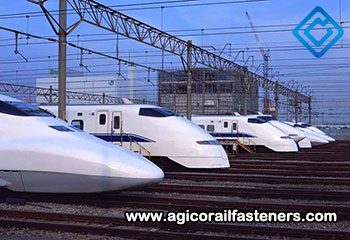New Trend from Ordinary High Speed Steel Rail to Continuous Welded Rail
Development of High Speed Steel Rail and Continuous Welded Rail
As we all known, ordinary rail lines use steel rails connect with rail joint bars. But nowadays, with the development of science and technology, there has a new trend from high speed steel rail to continuous welded rail.
Continuous welded rail (CWR) is to weld the standard length of rails together and form a long and continuous rail without gaps. It mainly includes two types: thermal stress and thermal stress dispersion.

In the era of high-speed railway, continuous welded rail is an important trend of modernization of rail with remarkable economic benefits. According to the statistics from government or institute, compared with normal rails, it can save at least 15% of regular maintenance costs than the ordinary steel rails, prolong 25% service life of rail. In addition, it can also reduce the resistance of train running and the noise of train vibration.
Throughout the history of railway construction worldwide, rail thermal expansion and contraction is always a difficult problem in the development. Since the first railway in the world was invented in Britain in1825, the problem has been disturbing human for 190 years. To solve it, there are three stages been experienced by us: gapless-gapping–gapless.
The first railway in Britain is constructed by a chain of welding between rails without gaps, which is described as the original version of continuous welded rail. In summer or winter with temperature rises up or down greatly, it was destroyed due to the functions of thermal expansion and contraction.
Later, people accepted the lesson and started to abandon the method of welding rails together in the past and use railroad fishplate and rail bolt to connect two steel rails with adequate clearance to deal with thermal expansion and contraction. The gap is called rail gap.

Although the design of rail gap can solve the problem of thermal expansion and contraction, a train in running has had a violent shock with “Click” noise due to rail gaps, which not only affects the comforts of passengers, but also cause the continuous impact of both train wheel and steel rail end so as to bring about the bending phenomenon that causes greater vibration again. This makes service life of train wheel and rail be greatly reduced, and brings difficulties for maintenance. Since 1960s, due to continuous improvement of technology, in order to solve the problem of rail gap, the researches on continuous welded rail has been spotlighted again in the world, which has a direct relationship with the world's rapid development of high speed railway.
Aren’t Continuous Welded Rail With Same Problem of steel rail Disturbed by Thermal Expansion and Contraction?
For railway track, there is apparently a joint between every two rails and a 6mm gap between the rail joints. It is very clear that the gap is used to prevent temperature force from the function of thermal expansion and contraction.
Do not underestimate the temperature force! Every time the rail temperature changes 1℃, it will bear 1.645tons of pressure or tension. The change of rail temperature is within range of 50℃, it will bear 82.2 tons of pressure or tension. The force will so strong that makes the rail be completely destroyed, therefore the track will become unsmooth, affecting safety of the train. Aren’t continuous welded rail disturbed by thermal expansion and contraction?

The law of conservation of matter tells us that any matter will not disappear. It is just changed from one form into another. Rail temperature force obeys it, too. The technology of thermal stress type of continuous welded rail to solve the thermal expansion and contraction is mainly realized by adjusting rail temperature itself.
Continuous Welded Rail Specific technical measures are:
-
Take the locked rail temperature (i.e. rail interval temperature under construction) as the standard control value; -
Be equipped with automatic monitoring of rail temperature and the facilities of heating and refrigeration. Adjust rail temperature by automatic monitoring control system for different regions, seasons, climates and temperatures; -
Starting corresponding heating or cooling facilities, to use transmission technology of normal temperature force and release the force automatically, so rail interval temperature will be controlled in the range of allowable values of locked temperature so as to realize that the rail will not expand as weather is hot and shrinkage as weather is cold.
Taking Beijing region for example, the highest rail temperature is 62.2℃; the lowest rail temperature is minus 22℃; the middle rail temperature is 19.9 ℃. According to calculation of strength and stability of continuous welded rail, the best locked rail temperature is 24℃ and the allowable is 19 ℃-29 ℃ in fact.
In addition, in order to keep the locked rail temperature, rail connecting parts and rail anchor are generally adopted in the PSC sleeper. In China high strength bolt, clip fastening system and so on are used to lock the rail.
We receive enquiries in English, Español (Spanish), Русский язык (Russian), Français (French) and العربية (Arabic). Our professional team will reply to you within one business day. Please feel free to contact us!



